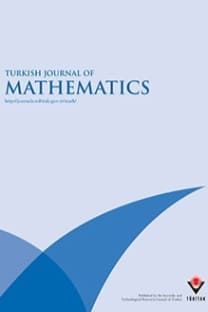On separating subadditive maps
Function spaces, separating maps, supports, subadditive maps
On separating subadditive maps
Function spaces, separating maps, supports, subadditive maps,
___
- Araujo J. Realcompactness and spaces of vector-valued functions. Fund Math 2002; 172: 27–40.
- Banach S. Theorie des operations lineares. New York, NY, USA: Chelsea, 1932 (in French).
- Beckenstein E, Narici L. Subadditive separating maps. Acta Math Hung 2000; 88: 147–167.
- Beckenstein E, Narici L. A nonarchimedian Banach-Stone theorem. Proc Amer Math Soc 1987; 100: 242–246.
- Beckenstein E, Narici L. The separating map: a survey. Rend Circ Mat Palermo 1998; 52: 637–648.
- Cech E. On bicompact spaces. Ann Math 1937; 38: 823–844. ˇ
- Sady F, Estaremi Y. Subadditive separating maps between regular Banach function algebras. Bull Korean Math Soc 2007; 44: 753–761.
- Stone M. Applications of the theory of Boolean rings to general topology. Trans Amer Math Soc 1937; 41: 375–481.
- Valov V. Spaces of bounded functions with the compact open topology. Bull Polish Acad Sci 1997; 4: 171–179.
- ISSN: 1300-0098
- Yayın Aralığı: 6
- Yayıncı: TÜBİTAK
Symplectic groupoids and generalized almost subtangent manifolds
Zero triple product determined generalized matrix algebras
A decomposition of transferable utility games: structure of transferable utility games
Some remarks on distributional chaos for bounded linear operators
Construction of self-reciprocal normal polynomials over finite fields of even characteristic
Saeid MEHRABI, Mahmood ALIZADEH
Companion inequalities to Ostrowski--Grüss type inequality and applications
Khalid Mahmood AWAN, Josip PECARIC, Mihaela Ribicic PENAVA
Generalized Heineken Mohamed type groups
Companion inequalities to Ostrowski Gr¨uss type inequality and applications
Khalid Mahmood AWAN, Josip PECARIC, Mihaela Ribicic PENAVA
On separating subadditive maps
Coextended weak entwining structures
Jos´e Nicanor ALVAREZ ALONSO, Jos´e Manuel VILABOA FERNANDEZ, Ramon RODRIGUEZ GONZALEZ
